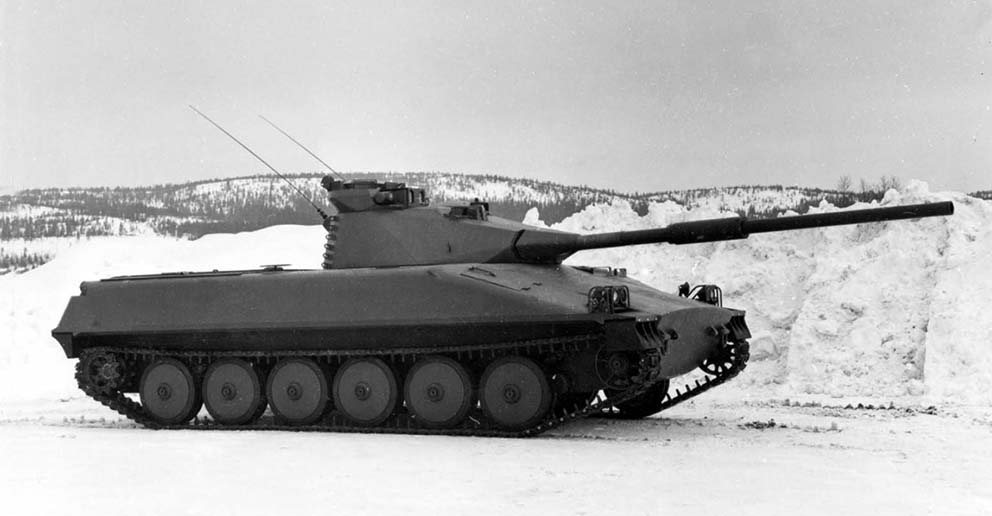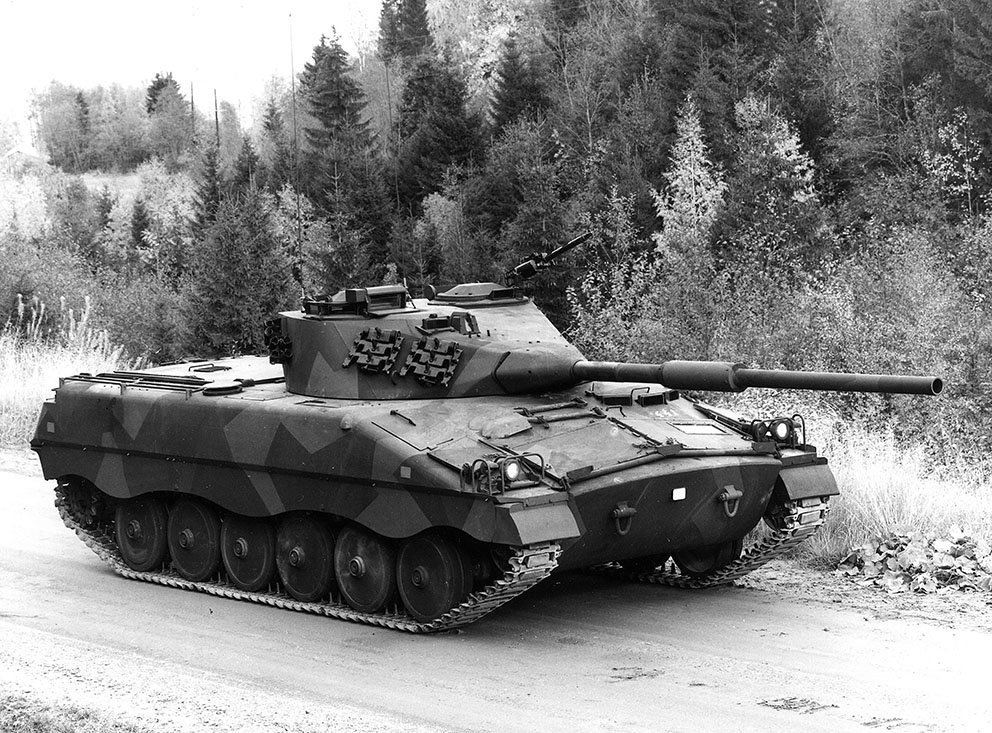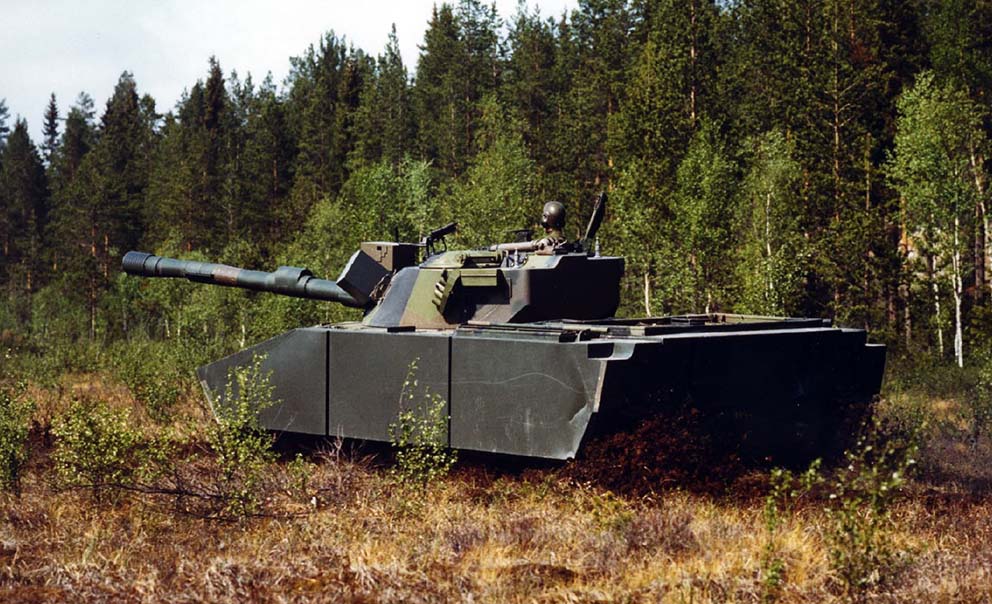Author: sp15
Well it’s finally time for another instalment of the Swedish
tanks series. But first I want to apologize for the lack of articles
from me. I have been busy collecting data on the Swedish medium branch
for WG and simply have not had that much time left over, anyhow lets get
this article started.
In the early 60s the vehicles in use by the Swedish infantry divisions
were quickly becoming obsolete. Many had been acquired during ww2 and
their age and variety meant that they shared little to nothing in the
way of the spare parts. Not only that but they also lacked the firepower
necessary on the modern battlefield. In an attempt to replace these
vehicles the Swedish army started a project called Ikv ny. After setting
up the requirements they contacted the three Swedish companies still
developing armored vehicles to come up with proposals for the project.
In 1965 a after 16 different proposals had been evaluated the army
decided to go with one of the proposals from Hägglunds & Söner.
Hägglunds
had come up with a number of proposals, most of which were perhaps a
bit too optimistic in terms of performance. But after scrapping ideas
for autoloaders and remote turrets the vehicle that remained would be
cheap (for tank standards) have most of its major components shared with
the Pbv 302 armored personnel carrier and meet the requirements set up
for the Ikv ny project. The Hägglunds proposal had proved marginally
more expensive than some of the other options but offered the advantages
of a fully traversable turret and that it could more easily be
converted to an amphibious vehicle. As per Swedish naming convention the
vehicle had been named after its armament and its intended role, this
gave the vehicle the designation Ikv 91 standing for infantry gun
carrier with 90mm with the 1 standing for it being the first of its
type. The question of the main armament itself had in fact been solved
early on in the project. A compromise had been made between the price
and the performance of the weapon. In the end a 9cm low pressure gun had
been chosen to make use of the existing ammunition developed for the
Pvpj 1110 recoilless rifle. The secondary armament consisted of a pair
of 7,62mm machineguns, one of which was mounted coaxially and one of
which was mounted on the turret for air defense. However the main
armament was seen as the weakest part of the vehicle and later there
would be numerous attempts to improve it.
Ikv 91 prototype
In 1968 the Swedish army placed an order for three prototypes, the first
of which was completed by late 1969 with the other two following in
early spring 1970. These prototypes were equipped with a complex fire
control system, the commander’s cupola was equipped with a laser
rangefinder and a ballistics computer. This allowed the commander to
detect and range a target for the gunner. Initially the prototypes
lacked a lot of the equipment that was later retrofitted like the
swimming gear and side skirts. The trials with the prototypes continued
for several years and eventually lead to a order of 212 vehicles by the
Swedish army. The production version followed in 1974-76 and had only
some minor changes compared to the prototypes. The most noticeable
change was the lack of the huge commander’s cupola but there was also
changes done to the layout of the engine deck. In general however
performance stayed the same although the production version was heavier
at 16,3 tons compared to the 14,5 tons of the prototypes.
Production version Ikv 91
Performance
The armor of
the Ikv 91 had been one of the things sacrificed in order to keep the
vehicle light and amphibious. This meant the ikv 91 ended up with a
maximum thickness of 20mm in the lower front with side and rear armor no
thicker than 8mm, although some parts were 4mm thick and covered by 8mm
of spaced armor. The engine that had been selected for the Ikv 91 was a
330hp turbocharged Diesel engine which was essentially an upgraded
version of the engine already in use by the Pbv 302. The low weight
coupled with the powerful engine gave the vehicle an excellent power to
weight ratio of over 20hp/t. This allowed the vehicle to operate in
parts of the country where tanks couldn’t normally be used due to the
harsh terrain. The high engine output also gave the Ikv 91 a respectable
top speed of 70 kph on roads and flat terrain. The Ikv 91 was crewed by
4 men, a driver placed in the left front of the hull, a Loader and
gunner placed in the left side of the turret with the commander on the
right. The 9cm low pressure gun allowed the Ikv 91 to provide infantry
with direct fire support with HE against soft targets even in rough
terrain thanks to its good mobility and its 10dg of gun depression, and
it would also be able to engage enemy tanks with the use of HEAT rounds
Projects for improvement
In
1971 even before the vehicle had entered production questions were
raised about its main armament. The low pressure gun would not allow the
use of APDS ammunition and the performance of HEAT rounds was thought
to be heavily negated on future tank designs by the use of stand-off
armor screens. Because of this one of the Ikv 91 prototypes had its
turret removed and was reworked into a test rig with a 105mm L7 gun
borrowed from a Centurion.
Ikv 91 test rig with 105mm L7 gun
At roughly the same time plans were drawn up for an improved ikv 91
under the designation UDES 14D which would feature better armor and a
new turret capable of mounting the L7 gun. This project would later lead
to at least 2 different prototypes. In the 1983 a prototype was
actually produced as a private venture by Hägglunds in an attempt to
sell the vehicle to India. The changes to this version included the
ability to fire its main armament while floating and also improved speed
in water. But despite being tested by several countries no orders were
placed. Hägglunds however kept improving the design and in the early
1990s they produced another prototype, this time for the Swedish army
which were planning on upgrading fleet of Ikv 91’s. The project however
fell tough as funding was cut following the fall of the Soviet Union.
This version became known as the Ikv 105 even though it was never
officially acquired by the Swedish army. Unlike the previous prototypes
this version was equipped with a Rheinmetall 105mm gun rather than the
L7 but was otherwise similar in performance to earlier models.
Interestingly this model was also trialed by the US marines but this
never led anywhere either.
UDES 14D
Ikv 105 prototype
Retirement
And so with no
money left for the upgrade and with the bad protection of the vehicle
all Ikv 91’s were taken out of use by the Swedish army in 2002. Some
last ditch efforts were made to convert the vehicles into mine clearing
vehicles or mortar platforms but these were also canceled. Today a
number of vehicles still remain in various museums, most notably
Bovington and the Arsenalen museum which actually has one of the
prototypes and two production vehicles. Overall the Ikv 91 was a pretty
good vehicle, it did meet its requirements and it was a fairly reliable
vehicle as well. However in the end it’s lacking firepower and
protection along with budget cuts lead to its early death.
In Wot
Although
you might think it’s a bit odd the Swedish army actually considered
this vehicle a tank destroyer rather than a light tank. Therefore I have
it listed as a tier 8 tank destroyer in my TD branch proposal. In this
role the vehicle would be rather similar to the British Charioteer in
that it would be a poorly armored but fast vehicle that would be using
the 105mm L7 gun as its top gun. Of course due to Wot’s somewhat
arbitrary tech limitations the Ikv 91 in game would be representated by
prototype version with the UDES 14D turret and 105mm L7 as upgrade
options. Perhaps not an ideal situation but definitely a workable
solution in my opinion.
Data: Ikv 91
Crew: 4 men
Combat weight: 16,3 tons
Length: 6,41 m
Width: 3 m
Height: 2,32 m
Ground clearance: 0,37 m
Engine: Volvo TD 120 A (330hp Diesel)
Top speed: 70 kph
Main armament: 9cm kan Ikv 91
Gun elevation: -10/+15
Ammunition carried: 59 rounds
Secondary armament: two 7,62mm Ksp m/39
Number produced: 212
Hull armor: 20/8/8
Turret armor: 10/12/12
As
for what is next from me i dont really know what to cover next, maybe
some more UDES project or the projects leading up to the Bkan 1 but dont
expect anything too soon. Anyway i hope you liked the article.







No comments:
Post a Comment